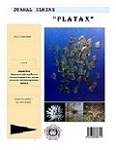Geographic Information System for Tuna Fishing Areas in Bitung waters
DOI:
https://doi.org/10.35800/jip.6.2.2018.21434Abstract
The existence of the fishing in the waters will always be dynamic, constantly changing or changed following the movement of environmental conditions, which naturally fish will choose a more appropriate habitat. Predicted zone of Tuna fish catch can be done by detecting the distribution of chlorophyll-a and sea surface temperature distribution from Aqua MODIS image. This study aims to predict the local zone tuna fishing in the sea around the city of Bitung based on the distribution of chlorophyll-a and sea surface temperature by using satellite image Aqua MODIS data level-3. A series of research activities are conducted in stages are: image collection, image cutting in accordance with the desired area, image extraction, data interpolation, map overlay, and the last is the map layout. The result of sea surface temperature (SST) and chlorophyll-a concentration in the ocean waters of Bitung and surrounding areas shows the chlorophyll-a and sea surface temperature varies each season. The highest chlorophyll-a distribution is in the second transitional season in September and the lowest in the west season in December. The highest sea surface temperature distribution is in the eastern seasons in June and the lowest in the eastern seasons in August. The results showed at some of the most potential fishing points of Tuna in the transitional season II wherein each month in the season potentially forming the Tuna fishing area
Keywords: Tuna, chlorophyll-a, SST, Aqua, Modis
Â
ABSTRAK
Â
Keberadaan daerah penangkapan ikan di perairan akan selalu bersifat dinamis, selalu berubah atau berpindah mengikuti pergerakan kondisi lingkungan, yang secara alamiah ikan akan memilih habitat yang lebih sesuai. Zona tangkapan ikan Tuna yang diprediksi dapat dilakukan dengan mendeteksi distribusi klorofil-a dan distribusi suhu permukaan laut dari citra Aqua MODIS. Penelitian ini bertujuan untuk memprediksi zona lokal penangkapan ikan tuna di laut sekitar kota Bitung, berdasarkan distribusi klorofil-a dan suhu permukaan laut dengan menggunakan citra satelit Aqua MODIS data level-3. Serangkaian kegiatan penelitian yang dilakukan secara bertahap adalah: koleksi gambar, pemotongan gambar sesuai dengan area yang diinginkan, ekstraksi gambar, interpolasi data, overlay peta, dan terakhir adalah tata letak peta. Hasil dari Suhu Permukaan Laut (SST) dan konsentrasi klorofil-a di perairan laut Bitung dan sekitarnya menunjukkan klorofil-a dan suhu permukaan laut bervariasi setiap musim. Distribusi klorofil-a tertinggi adalah pada musim peralihan kedua pada bulan September dan terendah di musim barat pada bulan Desember. Distribusi suhu permukaan laut tertinggi adalah di musim timur pada bulan Juni dan terendah di musim timur pada bulan Agustus. Hasil penelitian menunjukkan pada beberapa titik penangkapan ikan Tuna yang paling potensial pada musim peralihan II dimana setiap bulan di musim tersebut berpotensi membentuk daerah penangkapan Tuna.
Kata Kunci: Tuna, Chlorofil-a, SPL, Aqua, Modis
Downloads
Published
How to Cite
Issue
Section
License
COPYRIGHT
Authors who publish with this journal agree to the following terms:
Authors hold their copyright and grant this journal the privilege of first publication, with the work simultaneously licensed under a Creative Commons Attribution License that permits others to impart the work with an acknowledgment of the work's origin and initial publication by this journal.
Authors can enter into separate or additional contractual arrangements for the non-exclusive distribution of the journal's published version of the work (for example, post it to an institutional repository or publish it in a book), with an acknowledgment of its underlying publication in this journal.
Authors are permitted and encouraged to post their work online (for example, in institutional repositories or on their website) as it can lead to productive exchanges, as well as earlier and greater citation of the published work (See The Effect of Open Access).




















